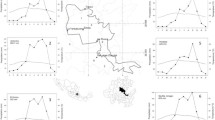Abstract
The use of the palm tree Borassus aethiopum Mart(Coryphoideae) by the Bassari ethnic group in the Republic of Guinea wasstudied. Ethnic groups have multiple uses for B. aethiopumthroughout its distribution in tropical Africa. The Bassari use this palm mostlyas a palm wine resource. As their harvesting technique leads to the death of thepalm, the populations of this species are highly endangered in the areapopulated by the Bassari. The fast decline of an important resource has recentlygained attention at governmental level. In order to conserve the populations ofthis palm, it is essential to understand whether the Bassari use a lethaltechnique because of socio-economic reasons or due to a lack of knowledge. Thepresent study aims to answer this question. We collected the data in thenorth-western part of the Republic of Guinea in May 1996 by field observationsand by using 'Rapid Rural Appraisal' tools consisting of interactiveinterviews with palm wine harvesters, collectors, carriers and sellers. Afterconstructing a woody ladder fixed to the stem the Bassari extract the sap bycutting a hole into the palm heart and by removing a small part of the palmheart two times per day. Individual trees produce on average 10 lper day. After 35–45 days the sap production ceases and thepalm dies. A harvester kills on average 56 individuals of B.aethiopum per year. As a consequence of this lethal techniqueexploiters have to constantly move through and between palm populations. Thereis no reforestation of the degraded areas. The palm wine extraction ofB. aethiopum is the main activity of the Bassari for 7months of the year. For harvesters, collectors, carriers andsellers, palm wine extraction provides one of the most important annual incomes.The harvester pays a monthly tax of USD 5 to the forestry administration.Despite its economic importance, the Bassari palm wine harvesters rangeB. aethiopum as the sixth most important plant species in the area. The paradoxical situation of acommunity that threatens a resource that it is highly dependent on may beexplained by the following circumstances. Firstly, the exploiters seek a maximumprofit on a short term basis. Secondly, the exploiters apparently do not takeinto consideration the total value of other potential products from theBorassus. Thirdly, the Bassari do not have an importanttradition for exploiting B. aethiopum so that there is noapparent cultural alliance between the Bassari and the palm. Finally, the rulesand regulations for harvesting Borassus products favourquick profit. The extinction of the palm population studied can be expectedwithin about 25 years if no protection measure is taken.
Similar content being viewed by others
References
Bellouard P. 1950. Le rönier en A.O.F. Bois et Forëts des Tropiques 14: 117-127.
Bismuth H. and Menage G. 1961. Les boissons alcooliques en A.O.F. Bulletin de l'Institut Franc¸ais d'Afrique Noire 23: 60-118.
Camara M.C., Diallo D. and Thies E. 1995. Les röneraies de la préfecture de Koundara: état actuel et propositions de gestion. Ministère de l'Agriculture, de l'Elevage et des Forêts, Conakry, République de Guinée, 64 pp.
Charest P. 1969. Relations inter-ethniques et changements socio-économiques dans' agglomération de Nyéméniki-Séguékho-Touba Diakha. Bulletin et Mémoire de la Société d'Anthropologie de Paris 5 (XIIe série): 101-229.
Chevalier A. 1949. Répartition géographique et exploitation des palmiers Borassus. Revue International de Botanique Appliquée et d'Agriculture Tropicale 315: 585-592.
Davis T.A. and Johnson D.V. 1987. Current utilization and further development of Palmyra palm (Borassus flabellifer L., Arecaceae) in Tamil Nadu State, India. Economic Botany 41: 247-266.
De Lestrange M. 1955. Les Coniagui et Les Bassari (Guinée française). Institut International Africain, Presses Universitaires de France, Paris.
Diallo D. 1997. Etude de la végétation des aires protégées de la Préfecture de Koundara. Ministère de l'Agriculture, de l'Elevage et des Forêts, Conakry, République de Guinée, 50 pp.
Diallo D. and Camara M.C. 1998. Atelier technique sur la disparition du rönier dans la sous-région ouest africaine. Ministére de l'Agriculture, de l'Elevage et des Forêts, Conakry, République de Guinée, pp. 20-30.
Diouf S. 1982. Le rônier au Sénégal. Mém. d'étude. ENSSAA, Dijon, France.
Giffard P.L. 1967. Le palmier rönier Borassus aethiopum Mart. Bois et Forêts des Tropiques 116: 3-12.
Giffard P.L. 1974. L'arbre dans le paysage sénégalais. Sylviculture en zone tropicale sèche. CTFT, Dakar, Senegal, 431 pp.
Ilboudo J.-B. 1987. La palmeraie naturelle a Elaeis guineensis Jacq. d'Oussouye (Basse Casamance-Sénégal)-Etude du milieu, inventaire, aspects socio-économiques. Mémoire de DEA. Université Cheikh Anta Diop, Dakar, Senegal, 104 pp.
Niang M. 1975. Le rönier dans la région de Thieè. Notes Africaines 147: 77-82.
Portères R. 1964. Le palmier rönier (Borassus aethiopum Mart.) dans la Province du Baoulé (Cöte d'Ivoire). Journal d'Agriculture Tropicale et de Botanique Appliquée 11: 499-514.
Sambou B. 1989. Rönier (Borassus aethiopum Mart.) et röneraies au Sénégal: état actuel et conditions de restauration. Thèse 3e Cycle. Université Cheikh Anta Diop, Dakar, Senegal.
Sambou B., Lawesson J.E. and Barfod A.S. 1992. Borassus aethiopum, a threatened multiple purpose palm in Senegal. Principes 36: 148-155.
Schönhuth M. and Kievelitz U. 1994. Participatory learning approaches. Rapid Rural Appraisal Participatory Appraisal-An introductory guide. GTW im TW-Verlag. Verlagsgesellshaft mbh, Rossdorf, Germany.
Uhl N.W. and Dransfield J. 1987. Genera Palmarum. Allen Press, Lawrence, Kansas.
Author information
Authors and Affiliations
Rights and permissions
About this article
Cite this article
Sambou, B., Goudiaby, A., Ervik, F. et al. Palm wine harvesting by the Bassari threatens Borassus aethiopum populations in north-western Guinea. Biodiversity and Conservation 11, 1149–1161 (2002). https://doi.org/10.1023/A:1016005025090
Issue Date:
DOI: https://doi.org/10.1023/A:1016005025090




